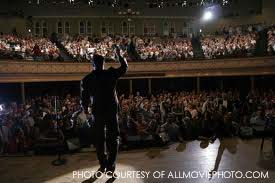
Let’s face it– we all love to laugh. Stand-up comedians do a great job of tapping into human emotions and making us break out into tear-inducing, stomach-clenching laughter.
What is it about their shows that make us laugh?
There are many forms of humor that comedians use to get us to laugh. Stand-up comedians, in particular, have a loosely planned act and do a lot of improvising.
Kevin Hart, a 31-year-old comedian from Philadelphia, has many different sources of inspiration that he pulls from during his shows.
Says Hart in an interview for the Chicago Tribune, “My experiences in life are getting bigger and better. The more stuff I do, the more stuff I talk about — having kids, traveling, going through relationship problems, dealing with things in my own family.” He is also greatly influenced by comedians from the past, such as Bill Cosby and Richard Pryor.
“I love his emotions and facial expressions when he performs,” says Kris Sherrod, a senior. He watches Kevin Hart often in his spare time.
There are dozens of forms of humor that comedians use to connect with their audience. One is anecdotal. This is when comedians use stories that are partly true, but somewhat made-up as well.
Richard Pryor, a former comedian (1940-2005), opened the doors for many African-American comedians who followed him. He used “blunt cadences” and street language, which was a risky move during this time. He was described in the New York Times as being able to “not only tell stories, but [to also] bring them to vivid life”. His use of anecdotal style appealed to his audience.
Another type of humor is called blue humor. Blue humor is also called off-color, or risque — when comedians use risky or slightly inappropriate material to get laughs from their audience. It can mean anything from controversial political topics to sexual situations.
Have you ever seen a comedian tell a really hilarious joke– but with a completely serious expression on their face? This is called deadpan or dry humor. When jokes are told with a “matter-of-fact” demeanor, it makes them easier for the audience to understand and, usually, strike them as funnier (awkward).
For example– comedian Steven Wright often used one-liners in his deadpan jokes: I went for a walk last night and my kids asked me how long I’d be gone. I said, “The whole time.”… Whose cruel idea was it for the word “lisp” to have an “s” in it?… Why do you press harder on a remote-control when you know the battery’s dead? and so on. These one-line jokes usually provoke laughs right after their delivery.
Ironic humor is just as it sounds– it is pointing out the irony of a particular story or situation. It is when the intended meaning is opposite of the literal meaning of something.
Sometimes, comedians will make themselves the target of their jokes. They use themselves and their previous misfortunes or experiences to make the audience laugh. This is called self-deprecating humor.
Rodney Dangerfield (1921-2004) used a lot of this in his shows. His catchphrase, “I don’t get no respect!”, embodies the use of self-deprecating humor. There’s irony in this statement because he was, in fact, a well-respected comedian and the fact that he used this phrase was funny. He performed most of these shows around this saying.
Situational humor is when comedians use specific situations to get laughs. This is the basis of most sitco (which is short for situational comedy). These types of comedy incorporate several other forms of humor, such as farce, screwball and slapstick.
“I think that people like watching comedians because they like to laugh,” says Sherrod. “Laughing relieves stress. It stops everything for that moment, and for that second you just feel happy. Who wouldn’t want that?”
Leave a Reply